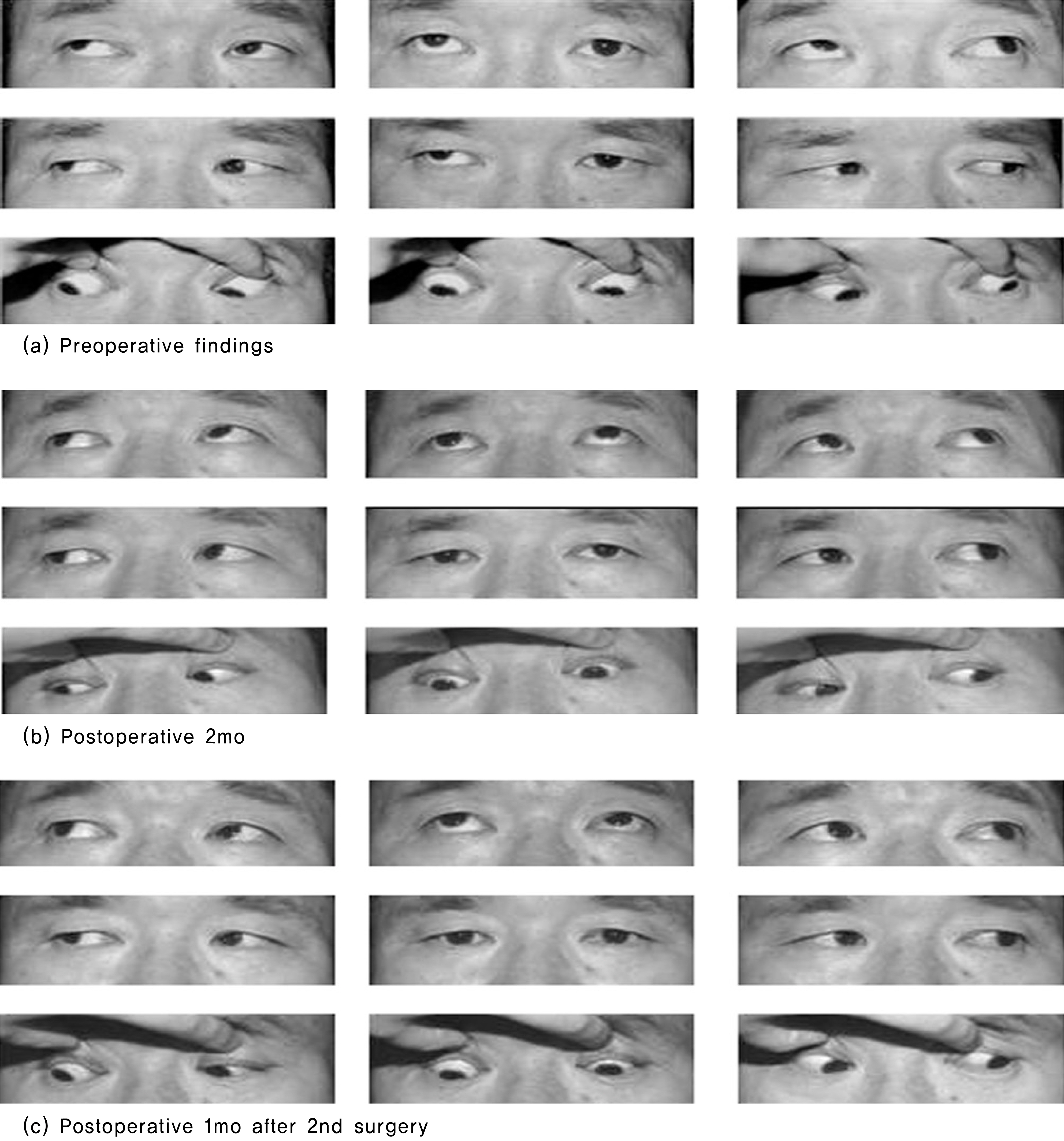J Korean Ophthalmol Soc.
2009 Dec;50(12):1902-1908. 10.3341/jkos.2009.50.12.1902.
Strabismus Surgery in Myasthenia Gravis
- Affiliations
-
- 1Department of Ophthalmology, Korea University College of Medicine, Ansan, Korea. ansaneye@hanmail.net
- KMID: 2213007
- DOI: http://doi.org/10.3341/jkos.2009.50.12.1902
Abstract
- PURPOSE
To report the results of strabismus surgery in five patients diagnosed with myasthenia gravis with strabismus.
CASE SUMMARY
The authors retrospectively analyzed the effect and timing of surgery for patients who developed strabismus after being diagnosed for myasthenia gravis. Cases 1 and 2 were female myasthenia gravis patients, eight and 45 years of age, who underwent surgery after symptoms developed for correction of exotropia at 33 months and ten years after diagnosis, respectively. Case 3 was a 33-year-old male hyperthyroidism patient who had an exotropia operation six years after his strabismus diagnosis. Cases 4 and 5 were a 22-year-old female and a 50-year-old male patient, who underwent surgery for correction of left hypotropia at 14 months and ten months after diagnosis, respectively. Eventually, a total of three cases of horizontal deviation and two cases of vertical deviation had successful outcomes resulting within ten prism diopters. The patients in cases 4 and 5, both of whom had vertical deviations, experienced a short wait time from the date of symptom presentation until they were able to receive surgery. In particular, case 5 developed left hypertropia two months prior to surgery and the strabismus angle increased until six months prior to surgery. However, the hypertropia stabilized afterwards and the patient finally obtained orthophoria after a left inferior rectus advancement operation.
CONCLUSIONS
In patients diagnosed with myasthenia gravis and a large angle strabismus, a longer follow-up period from diagnosis to operation is necessary for a successful postoperative outcome and stable strabismus angle.
Keyword
MeSH Terms
Figure
Reference
-
References
1. Vincent A, Willcox N, Hill M, et al. Determinant spreading and immune responses to acetylcholine receptors in myasthenia gravis. Immunol Rev. 1998; 164:157–68.
Article2. Heckmann JM, Owen EP, Little F. Myasthenia gravis in South Africans: racial differences in clinical manifestations. Neuromuscul Disord. 2007; 17:929–34.
Article3. Oöpik M, Puksa L, Luus S-M, et al. Clinical and laboratory- reconfirmed myasthenia gravis: a population-based study. Eur J Neurol. 2008; 15:246–52.4. Mantegazza R, Baggi F, Antozzi C, et al. Myasthenia gravis (MG): epidemiological data and prognostic factors. Ann N Y Acad Sci. 2003; 998:413–23.
Article5. Zhang X, Yang M, Xu J, et al. Clinical and serological study of myasthenia gravis in HuBei Province, China. J Neurol Neurosurg Psychiatry. 2007; 78:386–90.
Article6. Emilia-Romagna Study Group on Clinical and Epidemiological Problems in Neurology. Incidence of myasthenia gravis in the Emilia- Romagna region: a prospective multicenter study. Neurology. 1998; 51:255–8.7. Morris OC, O'Day J. Strabismus surgery in the management of diplopia caused by myasthenia gravis. Br J Ophthalmol. 2004; 88:832.8. Davidson JL, Rosenbaum AL, McCall LC. Strabismus surgery in patients with myasthenia. J Pediatr Ophthalmol Strabismus. 1993; 30:292–5.
Article9. Bentley CR, Dawson E, Lee JP. Active management of patients with ocular manifestations of myasthenia gravis. Eye. 2001; 15:18–22.10. Mein J, Harcourt B. Diagnosis and management of ocular motility disorders. Oxford: Blackwell;1986. p. 324–6.11. Glaser JS. Clinical ophthalmology. Philadelphia: Lipincott;1988. p. 31–7.12. Miller NR. Myopathies and disorders of neuromuscular transmission. Walsh and Hoyt's clinical neuro-ophthalmology. 4th ed.St Louis: Mosby;1987. p. 859–60.13. Acheson JF, Elston JS, Lee JP, Fells P. Extraocular muscle surgery in myasthenia gravis. Br J Ophthalmol. 1991; 75:232–5.
Article14. Bartley GB, Fatourechi V, Kadrmas EF, et al. Clinical features of Graves' ophthalmopathy in an incidence cohort. Am J Ophthalmol. 1996; 121:284–90.
Article15. Brodsky MC, Pollock SC, Buckley EG. Neural misdirection in congenital ocular fibrosis syndrome: implications and pathogenesis. J Pediatr Ophthalmol Strabismus. 1989; 26:159–61.
Article16. Christensen PB, Jensen TS, Tsiropoulos I, et al. Associated autoimmune diseases in myasthenia gravis. A population-based study. Acta Neurol Scand. 1995; 91:192–5.
Article







